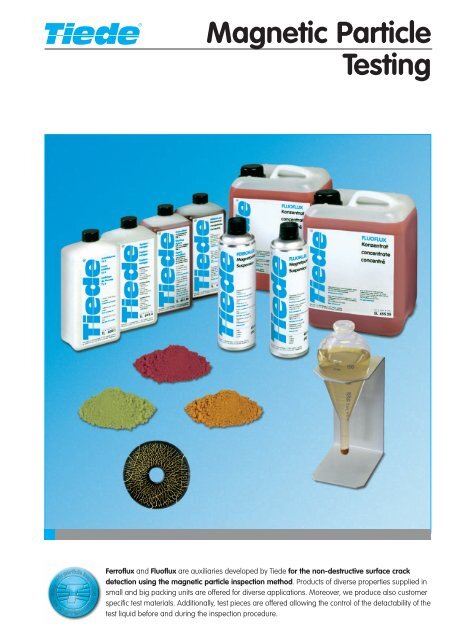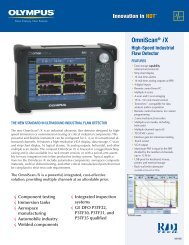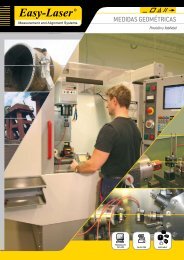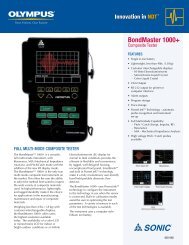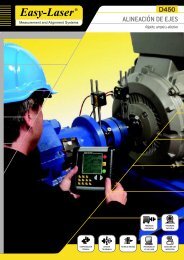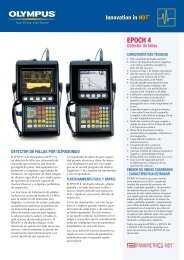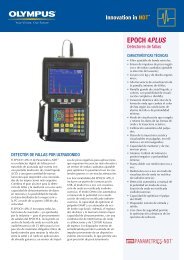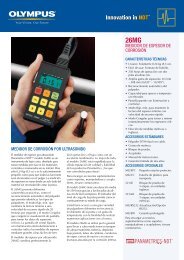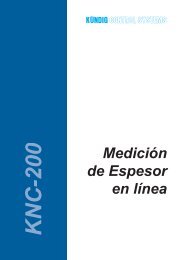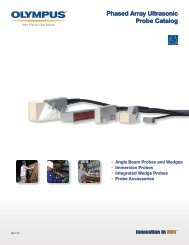Magnetic Particle Testing - Tecsud
Magnetic Particle Testing - Tecsud
Magnetic Particle Testing - Tecsud
You also want an ePaper? Increase the reach of your titles
YUMPU automatically turns print PDFs into web optimized ePapers that Google loves.
<strong>Magnetic</strong> <strong>Particle</strong><br />
<strong>Testing</strong><br />
Ferroflux and Fluoflux are auxiliaries developed by Tiede for the non-destructive surface crack<br />
detection using the magnetic particle inspection method. Products of diverse properties supplied in<br />
small and big packing units are offered for diverse applications. Moreover, we produce also customer<br />
specific test materials. Additionally, test pieces are offered allowing the control of the detactability of the<br />
test liquid before and during the inspection procedure.
Wet <strong>Testing</strong> Method<br />
suitable for<br />
Ref. Packing <strong>Particle</strong> for suspension in Fluorescent Daylight conventional automatic<br />
No. unit size oil water colour colour inspection inspection<br />
Fluoflux powder<br />
1 kg for 2500-5000 l of test liquid 601.1 1 kg-tin 3.0 µm * * yellow-green brown * –<br />
Fluoflux powder<br />
1 kg for 2500-5000 l of test liquid 601.2 1 kg-tin 8.3 µm * * bright green green * *<br />
Fluoflux powder<br />
1 kg for 2500-5000 l of test liquid 601.3 1 kg-tin 4.0 µm * * yellow-green olive-green * *<br />
Ferroflux powder<br />
1 kg for 100-200 l of test liquid 605.1 5 kg-bag 0.2 µm * * – black * –<br />
Fluoflux high concentrate without additives<br />
(wetting agent and rust inhibitor TN4, TR6<br />
or TNR6 must be added separately)<br />
1 l for 500-1000 l of water 604.1 1 l-bottle 3.0 µm – * yellow-green brown * –<br />
Fluoflux paste<br />
with wetting agent 612.10 100 g-tube<br />
100 g for 100 l of test oil 612.11 1 kg-tin 3.0 µm * – yellow-green brown * –<br />
Fluoflux concentrate<br />
with wetting agent<br />
1 l for 100 l of test oil 622.1 1 l-bottle 3.0 µm * – yellow-green brown * –<br />
Additives<br />
for wet testing method with water<br />
to be used with above mentioned<br />
Fluoflux resp. Ferroflux products<br />
Spraying and<br />
suitable for<br />
Ref. Packing silicone- free from chlorides nitrite- suspension conventional automatic<br />
No. unit free (halogens) free effect inspection inspection<br />
Wetting agent with defoamer TN 4<br />
1 l for 500-1000 l of water 608.1 1 l-bottle – * * very good * *<br />
Wetting agent with defoamer TN 5<br />
1 l for 500-1000 l of water 608.2 1 l-bottle * * * very good * *<br />
Defoamer TS 4<br />
1 l for 1000-10000 l of water 609.1 1 l-bottle – * * – * *<br />
Defoamer TS 5<br />
1 l for 500-1000 l of water 609.2 1 l-bottle * * * – * *<br />
Rust inhibitor concentrate TR 6 618.10 1 l-bottle<br />
1 l for 100-200 l of water 618.50 5 l-can<br />
618.20 30 l-can * * * – * *<br />
Wetting agent with defoamer<br />
and rust inhibitor TNR 6<br />
1 l for 100-200 l of water 617.10 1 l-bottle – * * good * *<br />
Wetting agent with defoamer<br />
and rust inhibitor TNR 7<br />
1 l for 100-200 l of water 617.20 1 l-bottle * * * good * *<br />
Test oils<br />
for wet testing method with oil<br />
to be used with above mentioned<br />
Fluoflux products<br />
Corrosion<br />
suitable for<br />
Ref. Packing fluores- Flash level according conventional automatic<br />
No. unit cence-free point Viscosity to DIN 51360 inspection inspection<br />
Test oil 620.1 30 l-can<br />
620.2 200 l-barrel * 60° C 20° C: 2 cSt 0 * *<br />
Safety test oil 620.10 30 l-can<br />
620.20 200 l-barrel * >100° C 20° C: 3.3 cSt 0 * *
Test materials<br />
Concentrates<br />
for wet testing method<br />
suitable for<br />
Fluores- Day- sili- free from Corrosion<br />
Ref. Packing <strong>Particle</strong> for suspension in cent- light cone- chlorides nitrite- level acc. to conventional automatic<br />
No. unit size oil water colour colour free (halogens) free DIN 51360 inspection inspection<br />
Fluoflux concentrate<br />
with wetting agent,<br />
defoamer and rust inhibitor 633.10 1 l-bottle yellow-<br />
1 l for 50 l of water 633.50 5 l-can 3.0 µm – * green brown – * * 3 * *<br />
Fluoflux concentrate<br />
with wetting agent, defoamer<br />
and strong rust inhibitor<br />
1 l for 20-40 l of water 655.1 1 l-bottle yellow-<br />
655.5 5 l-can 3.0 µm – * green brown * * * 0 * *<br />
1 l for 40 l of water 655.2 1 l-bottle yellow-<br />
655.25 5 l-can 3.0 µm – * green brown * * * 0 * *<br />
Fluoflux concentrate<br />
with increased powder, with<br />
wetting agent, defoamer<br />
and strong rust inhibitor 655.15 1 l-bottle yellow- 0 (40 l)<br />
1 l for 40-80 l of water 655.55 5 l-can 3.0 µm – * green brown * * * 3 (80 l) * *<br />
Ferroflux concentrate<br />
with wetting agent,<br />
defoamer and rust inhibitor,<br />
1 l for 50 l of water 616.1 1 l-bottle 0.2 µm – * – black – * * 3 * –<br />
Fluoflux suspension<br />
ready-to-use 622.1 G 10 l-can 3.0 µm suspended in oil yellow- brown * * * – * –<br />
green<br />
Aerosols<br />
for wet testing method<br />
in oil<br />
suitable for<br />
Corrosion<br />
Ref. Packing <strong>Particle</strong> Fluorescent Daylight carrier pro- level acc. to conventional automatic<br />
No. unit size colour colour medium pellent DIN 51360 inspection inspection<br />
Fluoflux magnetic 400 ml compr.<br />
powder suspension 690.1 aerosol 3.0 µm yellow-green brown oil air 0 * –<br />
Ferroflux magnetic 400 ml compr.<br />
powder suspension 690.2 aerosol 0.2 µm – black oil air 0 * –<br />
Dry <strong>Testing</strong><br />
Method<br />
Accessories for magnetic particle testing<br />
Special accessories<br />
suitable for<br />
Ref. Packing <strong>Particle</strong> Fluores- Daylight conventional automatic<br />
No. unit size cent colour colour inspection inspection<br />
Fluoflux powder - fine - 610.2 5 kg-bag 0.1 - 0.2 mm yellow-green – * –<br />
Ferroflux powder 611.2 5 kg-bag 0.1 - 0.2 mm – grey * –<br />
Ferroflux powder 611.04 5 kg-bag 0.15 mm – red * –<br />
Ferroflux powder 611.03 5 kg-bag 0.15 mm – yellow * –<br />
Background colour<br />
System cleaner<br />
to brighten the component surface<br />
to clean and desinfect the test material tank<br />
when Ferroflux powders are used<br />
and the system<br />
Colour: white<br />
400-ml<br />
Propellent: CFC-free 695.1 aerosol 1 l for 50-100 l of water 695.4 1 l-bottle<br />
Special cleaner 400-ml Rust inhibitor concentrate US 1<br />
for background colour white 695.2 aerosol for ultrasonic immersion techniques,<br />
free from chlorides and halogens,<br />
nitrite-free 640.5 5 l-can<br />
1 l for 25-50 l of water 640.25 25 l-can<br />
Do you have questions<br />
as to our test liquids?<br />
Our test liquid<br />
department<br />
(Tel. +49 (0) 7365 / 81-132)<br />
will be pleased to assist<br />
you for any further<br />
information.<br />
We are producing also<br />
individual test liquids<br />
specifically designed for<br />
your requests.
Test piece<br />
ASTM centrifuge tube<br />
with stand<br />
Ref. No. 135 015<br />
The exact portion of magnetic<br />
powders suspended in oil or<br />
water can be determined with<br />
the centrifuge tube.<br />
If the concentration is correctly mixed,<br />
a certain number of graduation marks<br />
must be obtained after a settling time<br />
of 30 minutes.<br />
<strong>Magnetic</strong> particle suspensions already<br />
circulating in pump circuits should no<br />
longer be checked with the centrifuge<br />
tube, because dirt paricles deteriorate<br />
the result.<br />
Reference test piece type 1<br />
with reference photo<br />
Ref. No. 135 012<br />
acc. to. pr. EN ISO 9934-2 appendix B<br />
(MTU No. 3)<br />
When using magnetic paricle suspensions it is of overall<br />
importance to check the indication efficiency of the test material.<br />
Hydromechanical stresses in pump circuits, separated particles,<br />
too weak or too concentrated test material mixture could affect the<br />
operational efficiency. The test material is simply sprayed on the<br />
test piece to see whether is still efficient.
Why is a defect indicated?<br />
When a ferromagnetic material is magnetized, magnetic flux will<br />
flow within the magnetically conducting medium. When the flux<br />
lines meet an area of low magnetic conductivity, i.e. a surface<br />
crack, the associated high magnetic resistance changes the flux<br />
distribution.<br />
The field lines in the sound<br />
magnetic strayflux<br />
material are diverted, a small<br />
proportion passing through<br />
the material defect, but the<br />
majority are diverted out of<br />
the surface to form a bridge<br />
over the defect. The field lines<br />
diverted out of the surface are<br />
termed ”magnetic strayflux”<br />
and form the basis of magnetic<br />
powder techniques. With these techniques the magnetic strayflux<br />
is identified by applying fine iron powder or iron-oxide powder<br />
to the workpiece surface.<br />
The magnetic strayflux lines are moving in a basically non-conducting<br />
medium, and are therefore exposed to a relatively high magnetic<br />
resistance.<br />
To reduce this magnetic resistance the stray fields attract all the<br />
nearest freely-moveable iron particles which combine to form a<br />
magnetic bridge over the defect.<br />
The combination in the shape of a powder pattern can be easily<br />
identified as a defective area.<br />
Physical basic conditions<br />
What can be tested?<br />
All ferromagnetic materials with a permeability of µ > 100.<br />
The range of ferromagnetic materials includes:<br />
• All types of steel and their alloys with the exception<br />
of austenitic steels<br />
• Cast iron<br />
What can be detected?<br />
All surface and near surface crack-type defects which, due to their<br />
position and size, proportionally influence the magnetic field,<br />
providing that the crack width-depth-length dimensions are in the<br />
ratio > 1 – 10 – 50.<br />
Indication sensitivity to near-surface defects and inclusions rapidly<br />
reduces as their depth increases.<br />
When can a defect be detected?<br />
Optimum crack detection occurs when the magnetic field lines are<br />
at right-angles to the defect. The angle between the field direction<br />
and the expected defect position should not, however, be greater<br />
than 30°.
Magnetisation techniques<br />
in accordance with DIN EN ISO 9934-1<br />
Yoke magnetisation<br />
Alternating current yoke<br />
Open W-yoke – A magnetic circuit, determined by the<br />
mains frequency of 50/60 Hz is completed through air;<br />
there is a constant field polarity reversal and with open<br />
yokes the maximum clamping length = 1000 mm.<br />
Closed W-yoke – A closed iron core is used and when<br />
the test piece is clamped the majority of the magnetic<br />
field lines are constrained within the iron core; an alternating<br />
field can therefore be maintained over a larger<br />
distance.<br />
Maximum clamping length = 1200 mm<br />
D.C. yoke<br />
Arrangement for test units with D.C. yokes<br />
Crack indications: Transverse cracks<br />
Advantages:<br />
• Robust construction<br />
• Longest possible clamping lengths<br />
Crack indication: Transverse cracks<br />
Advantages:<br />
• Uniform field distribution even with complicated<br />
shaped parts with large cross-sectional changes.<br />
• Can be adapted for induction fluxing techniques.<br />
• Simple and rapid de-magnetisation of the test<br />
piece.<br />
Disadvantages:<br />
• Expensive construction<br />
• Limited clamping length<br />
Disadvantages:<br />
• Stray field formation at the rounded ends of<br />
workpieces.<br />
• Considerable field reduction with large<br />
cross-sectional changes of the test piece.<br />
• Expensive to de-magnetise the test piece.<br />
Magnetisation with<br />
current flowing conductor<br />
Coil magnetisation (solid or moveable coil)<br />
Crack indications: Transverse cracks<br />
Indications at 90° to the magnetic field or in the<br />
current direction i.e. in accordance with the<br />
direction of the coil windings.<br />
Criteria:<br />
• When testing tubes in conjunction with alternating<br />
current, only the outside surface is magnetised.<br />
• Because the magnetic field lines are introduced at<br />
right-angles to the plane surface of the material,<br />
circular cracks may be indicated with reduced<br />
sensitivity.<br />
Straight-through-conductor<br />
(Threading bar technique)<br />
Crack indications: Longitudinal cracks<br />
Internal and external, star-like cracks running from<br />
the centre to the outside on the plane surface.<br />
Advantages:<br />
• Contactless magnetisation, and therefore no<br />
danger of burning.<br />
• When A.C. is used the tube is only internally<br />
magnetised.<br />
Direct fluxing<br />
Axial direct fluxing<br />
Crack indications: Longitudinal cracks<br />
Indications at 90° to the magnetic field or in the<br />
direction of the current i.e. in a direct line between<br />
both contact poles.<br />
Criteria:<br />
• Crack indications at the contact points not possible.<br />
• With dirty contact points there is a danger<br />
of burning.<br />
• With very high current strengths the test piece<br />
heats up.<br />
Induction fluxing<br />
Requirements for carrying out induction fluxing<br />
• Only closed ring or tube-shaped test pieces can<br />
be inspected by means of the circulating induction<br />
current.<br />
• A dynamic field is necessary for the generation of an<br />
induction current.<br />
i.e. alternating current can only be used for induction<br />
fluxing.<br />
Crack indication: Circulating defects<br />
All circulating defects, internal, external and at<br />
both plane surfaces.<br />
Advantages:<br />
• Contactless magnetisation and therefore no<br />
danger of burning.<br />
• Good possiblities of combining with indirect<br />
fluxing, for contactless detection of defects of all<br />
directions (finished part testing).<br />
11/02 · g+r<br />
Tiede GmbH + Co · Bahnhofstr. 94-98 · D-73457 Essingen · Tel. +49 (0) 73 65/81-0 · Fax +49 (0) 73 65/81-449 · info@tiede.de · www.tiede.de
UV-LED- Portable light<br />
UV-Lights<br />
mit Netzteil<br />
with mains supply<br />
Ref.-No. 121200<br />
with mains supply in a handy case<br />
UV-LED<br />
The Tiede portable UV-Light captivates with its totally<br />
new UV-LED technique and its light and compact design.<br />
It goes without saying that it meets the latest standards<br />
and regulations.<br />
with Accu Pack<br />
Ref.-No. 121201<br />
with Accu pack and battery charger<br />
in a handy case<br />
Features:<br />
<br />
meets DGZfP-requirements<br />
long life-time of light medium<br />
compact design<br />
emission only in the UV-A-range<br />
no UV-B-portion, thus no health<br />
hazard for the operator<br />
UV-Intensity (distance 300 mm) 18 W/m²<br />
clearly defined UV-A-range<br />
<br />
<br />
no warm-up<br />
no transformer, therefore<br />
perfect for inspection in tanks<br />
UV-LED an mains supply meets IP 65<br />
Accu pack meets IP 54<br />
The new Tiede UV-light can be operated with a 230 V mains supply or with a separate accu pack<br />
We reserve the right of modifications serving the technical progress.
Accessories for the UV-LED<br />
UV-Lights<br />
Accu Pack<br />
for the current supply of the UV-LED<br />
Accumulator pack with 20 cells NiMH/2300 mAh.<br />
Protection class: IP 54<br />
Operating time of the lamp with fully charged accu pack with 40 % cycle time<br />
approx. 8 h<br />
The operation with accu pack in closed containers is absolute acceptable.<br />
For the charging only the Tiede battery charger Ref.-No. 121207 must be used!<br />
Ref.-No. 121 206<br />
Battery Charger<br />
for the accu pack of UV-LED. The battery charger must directly be connected<br />
to the accumulator pack (without shiner feed line).<br />
Ref.-No. 121 207<br />
Mains Supply<br />
110-240 V / 50/60 Hz<br />
Protection class: IP 6´5<br />
Operation in closed container<br />
On Operation with power supply (in preparation) it is absolutely<br />
necessary, that the power supply is outside of the closed container.<br />
Ref.-No. 121 205<br />
Shiner feed line<br />
5 m<br />
Ref.-No. 121 210<br />
10 m<br />
Ref.-No. 121 211<br />
The new Tiede UV-light can be operated with a 230 V mains supply or with a separate accu pack.<br />
We reserve the right of modifications serving the technical progress.
Pumps and Spraying Devices<br />
for magnetic powder suspensions<br />
The original TIEDE accessories presented in this leaflet are certified equipment and additional auxiliaries.<br />
Each item has been tested in combination with TIEDE products and stand its test in the operational praxis.<br />
Operation manuals are provided, as far as necessary.
Pumps and Spraying Devices<br />
for magnetic powder suspensions<br />
Plastic hand spray pump<br />
Spray pressure agitated manual pump<br />
• Adjustable spray jet<br />
• Spray nozzle swiveling in any direction<br />
• Capacity: 1 l<br />
Ref.No. 129 402<br />
Portable test liquid tank<br />
• Complete with container and hand hose<br />
• Capacity: 8 l<br />
• Power supply: 3 x 400 V<br />
(circuit breaker)<br />
• Output quantity: 25 l/min. at 3 m throughput height<br />
or 40 l/min. at 2 m throughput height<br />
Ref.No. 129 410<br />
230 V power supply available on request<br />
Mobile test liquid tank<br />
• Incl. light metal drip tray to recollect test liquid<br />
to container<br />
• Spraying via hand hose<br />
• Capacity: 8 l<br />
• Power supply: 3 x 400 V<br />
(circuit breaker)<br />
• Output quantity: 25 l/min. at 3 m throughput height<br />
or 40 l/min. at 2 m throughput height<br />
Ref.No. 129 415<br />
230 V power supply available on request<br />
Stationary test liquid container<br />
• Stainless steel container<br />
• Pump with cover can be easily removed<br />
• Spraying via hand hose<br />
• Capacity: 40 l<br />
• Power supply: 3 x 400 V<br />
(circuit breaker)<br />
• Output quantity: 25 l/min. at 8 m throughput height<br />
Ref.No. 129 420<br />
Tiede GmbH + Co · Bahnhofstr. 94-98 · D-73457 Essingen · Tel. +49 (0) 73 65/81-0 · Fax +49 (0) 73 65/81-449 · www.tiede.de<br />
09/03 · g+r
<strong>Magnetic</strong> field strength<br />
measuring instrument<br />
Measuring instrument<br />
The new micro-processor controlled<br />
Tiede FSM 2 magnetic field strength instrument<br />
combines the advantages of the well-known<br />
FSM-1, such as easy handling, reliability and<br />
durability with the exiting new features to meet<br />
the demanding requirements of the performance<br />
standards in the non-destructive material testing<br />
industry<br />
Developed for use in the tough enviroment<br />
of manufacturing industry, the new FSM 2<br />
excels with important features:<br />
• Measuring units:<br />
kA/m , Amps/cm, Oe, T and G<br />
• Measuring range:<br />
0 to ± 400 Amps/cm<br />
meets IP 65 (membrane keyboard)<br />
• True-RMS of mixed fi elds<br />
• Measuring value holding function<br />
• D.C. fi eld measurement<br />
• Function selection by menu control<br />
• High-solution display 120 x 32 pixels<br />
• Background illumination of display<br />
• Automatic switch-off<br />
• Battery level indication<br />
• Battery and mains supply operation<br />
• Optional RS 232 data transfer<br />
The new FSM 2 is supplied in a carrying case including the mains supply unit, tangential field probe<br />
and a 100 Amps/cm calibration standard.<br />
Specifi cation subject to change without notice.<br />
info@tiede.de to take an offer<br />
Tiede GmbH + Co . Bahnhofstr. 94-98 . D-73457 Essingen . Tel. + 49 (0) 73 65/81-0 . Fax + 49 (0) 73 65/81-449 . www.tiede.de


